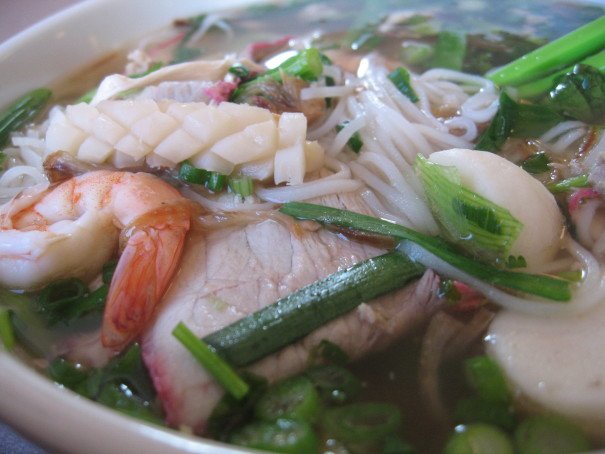
Eating Street Food at a Five‑Star Resort

Eating Street Food at a Five‑Star Resort
Kuy Teav at a Cambodian Resort
When our waiter brought over a steaming bowl of kuy teav, or Cambodian beef noodle soup, it was love at first whiff for my olfactory senses. Lime-infused, with a thick, pork-based broth, the aroma of kuy teav is not nearly as discernable as the more famous Vietnamese pho or Thailand’s Pad Thai. Rather, it possesses a subtle seductiveness that grows on your taste buds.
Hotel breakfasts are among the most underrated gastronomical experiences. It wasn’t always like this. There was a time way back yonder (the 90s) when it was okay to be seen indulging in a hearty bowl of noodle soup on your hotel balcony and not be sneered at for being a snob (at least not to your face). Growing up in Southeast Asia with parents who loved to travel, this was the closest I had to having a morning regiment. It was my “comfort food,” so to speak. Whatever perilous adventures lay ahead that day, I knew I could conquer them all on a full, satisfied stomach.
Then, something changed. All of a sudden, I felt this immense pressure that as a young traveler—and especially a journalist—I had to wake up at the crack of dawn to seek out hole-in the-wall joints and line up at street carts just to try some kind of rare local delicacy. And that by not doing so, I wasn’t fully immersing myself in the local culture.
So when my travel companion contracted a severe case of salmonella and was hospitalized for two weeks this summer in Taiwan, I was secretly elated. This meant that we would be avoiding street food during our upcoming trip to Cambodia.
And I was right. We were pampered the minute we arrived in Siem Reap. Our hotel had an interesting, if elitist, concept, down to the way food was served. The top floor of the hotel is called The Privilege Floor, and guests staying there have access to a personal assistant and chauffeur, as well as a separate dining nook serving all-day complimentary breakfast.
After exchanging morning greetings with our personal assistant, our waiter showed us to a table on a balcony decked with potted plants overlooking scattered palm trees and rickety houses with makeshift hammocks in their gardens. Above us, antique fans made creaking noises as they swiveled, while the lime-green pillows and paintings of plants created a cool, tropical feel that contrasted greatly with the red dirt roads below.
I was savoring my noodles while thinking it was a little silly to be eating kuy teav at a five-star resort, especially when it can be bought cheaply and readily from any roadside vendor. Said to have originated from Chinese immigrants to Cambodia, kuy teav is a fusion that works well. The thin white rice noodles and tender, delicately sliced beef were neatly soaked in the soup, which was only mildly spicy. Herbs and spices were minimal as the main flavoring emanated from the broth, although the spring onion garnish was a nice touch. Warm, thick, and a little frothy, kuy teav walks the line of acceptable breakfast food, just avoiding being too heavy.
As I slurped the last drop of warm soup, I glanced at my surroundings—the plush green pillows, the antique ceiling fans, and a waiter that addressed us by name—the frills that made all the difference. I felt a little sheepish about not stopping at that roadside vendor, but that’s a price I was willing to pay.